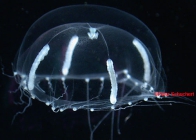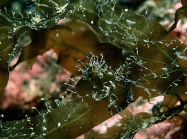
| About | | Search taxa | | Taxon tree | | Search literature | | Checklist | | Stats | | Log in |
WoRMS taxon detailsClytia Lamouroux, 1812
117030 (urn:lsid:marinespecies.org:taxname:117030)
accepted
Genus
Campanularia johnstoni Alder, 1856 accepted as Clytia hemisphaerica (Linnaeus, 1767) (type by subsequent designation)
Clytia (Platypyxis) L. Agassiz, 1862 · unaccepted (synonym)
Clytia (Trochopyxis) L. Agassiz, 1862 · unaccepted (synonym)
Epenthesis McCrady, 1859 · unaccepted (synonym)
Eucope Gegenbaur, 1857 · unaccepted
Eucopium Haeckel, 1879 · unaccepted
Phialidium Leuckart, 1856 · unaccepted (synonym (medusa based))
Pseudoclytia Mayer, 1900 · unaccepted (synonym)
Thaumantias Eschscholtz, 1829 · unaccepted (synonym)
marine,
recent only
Lamouroux, J. V. F. (1812). Extrait d'un mémoire sur la classification des Polypiers coralligènes non entièrement pierreux. Nouveau Bulletin scientifique de la Société Philosophique, 3: 181-188, available online at https://www.biodiversitylibrary.org/page/31775884
page(s): 184 [details]
Schuchert, P.; Choong, H.; Galea, H.; Hoeksema, B.; Lindsay, D.; Manko, M.; Pica, D. (2025). World Hydrozoa Database. Clytia Lamouroux, 1812. Accessed through: World Register of Marine Species at: https://www.marinespecies.org/aphia.php?p=taxdetails&id=117030 on 2025-07-16
Date action by
Nomenclatureoriginal description
Lamouroux, J. V. F. (1812). Extrait d'un mémoire sur la classification des Polypiers coralligènes non entièrement pierreux. Nouveau Bulletin scientifique de la Société Philosophique, 3: 181-188, available online at https://www.biodiversitylibrary.org/page/31775884 page(s): 184 [details] original description (of Phialidium Leuckart, 1856) Leuckart, R. 1856. Beiträge zur Kenntniss der Medusenfauna von Nizza. - Archiv für Naturgeschichte 22: 1-40, pls 1-2., available online at https://www.biodiversitylibrary.org/page/7083410 page(s): 18 [details] original description (of Thaumantias Eschscholtz, 1829) Eschscholtz, F. (1829). System der Acalephen. Eine ausführliche Beschreibung aller medusenartigen Strahltiere. Ferdinand Dümmler, Berlin, pp. 1-190, 116 pls., available online at https://www.biodiversitylibrary.org/page/10665047 page(s): 102 [details] original description (of Pseudoclytia Mayer, 1900) Mayer, A. G. (1900). Some medusae from the Tortugas, Florida. <em>Bulletin of the Museum of Comparative Zoology of Harvard.</em> 37: 13-82, pls 1-44., available online at https://www.biodiversitylibrary.org/page/4271669 page(s): 53 [details] original description (of Eucope Gegenbaur, 1857) Gegenbaur, C. (1857). Versuch eines Systems der Medusen, mit Beschreibung neuer oder wenig gekannter Formen; zugleich ein Beitrag zur Kenntnis der Fauna des Mittelmeeres. <em>Zeitschrift für wissenschaftliche Zoologie.</em> Leipzig 8: 202-273, pls 7-9., available online at https://www.biodiversitylibrary.org/page/13864647 page(s): 241 [details] original description (of Epenthesis McCrady, 1859) McCrady, J. 1859. Gymnopthalmata of Charleston Harbor. Proceedings of the Elliott Society of Natural History 1: 103-221, pls 8-12. , available online at https://www.biodiversitylibrary.org/page/42536587 page(s): 191 [details] original description (of Clytia (Trochopyxis) L. Agassiz, 1862) Agassiz, L. (1862). Contributions to the natural history of the United States of America. <em>Little Brown, Boston.</em> 4: 1-380, pls 1-19., available online at https://www.biodiversitylibrary.org/page/16068829 page(s): 304 [details] original description (of Clytia (Platypyxis) L. Agassiz, 1862) Agassiz, L. (1862). Contributions to the natural history of the United States of America. <em>Little Brown, Boston.</em> 4: 1-380, pls 1-19., available online at https://www.biodiversitylibrary.org/page/16068829 page(s): 306 [details] original description (of Eucopium Haeckel, 1879) Haeckel, E. (1879). Das System der Medusen. Erster Teil einer Monographie der Medusen. <em>Denkschriften der Medicinisch-Naturwissenschaftlichen Gesellschaft zu Jena.</em> 1: XX+1-360, 320 plates., available online at https://www.biodiversitylibrary.org/page/32605578 page(s): 168 [details] basis of record van der Land, J.; Vervoort, W.; Cairns, S.D.; Schuchert, P. (2001). Hydrozoa, <B><I>in</I></B>: Costello, M.J. <i>et al.</i> (Ed.) (2001). <i>European register of marine species: a check-list of the marine species in Europe and a bibliography of guides to their identification. Collection Patrimoines Naturels,</i> 50: pp. 112-120 (look up in IMIS) [details] Taxonomyredescription
Cornelius, P.F.S., 1982. Hydroids and medusae of the family Campanulariidae recorded from the eastern North Atlantic, with a world synopsis of genera. Bull. Br. Mus. nat. Hist., Zool. 42 2: 37-148. page(s): 70 [details] Othercontext source (Hexacorallia)
Fautin, Daphne G. (2013). Hexacorallians of the World. (look up in IMIS) [details]
additional source Brunel, P., L. Bosse & G. Lamarche. (1998). Catalogue of the marine invertebrates of the estuary and Gulf of St. Lawrence. <em>Canadian Special Publication of Fisheries and Aquatic Sciences, 126.</em> 405 pp. (look up in IMIS) [details] Available for editors additional source MacNae, W. & M. Kalk (eds). (1958). A natural history of Inhaca Island, Mozambique. Witwatersrand Univ. Press, Johannesburg. I-iv, 163 pp. [details] additional source Integrated Taxonomic Information System (ITIS). , available online at http://www.itis.gov [details] additional source Bouillon, J.; Boero, F. (2000). Synopsis of the families and genera of the Hydromedusae of the world, with a list of the worldwide species. <i>Thalassia Salent. 24</i>: 47-296 (look up in IMIS) [details] additional source Lira, S.M.A., Farrapeira, C.M.R., Amaral, F.M.D. & Ramos, C.A.C. (2010). Sessile and sedentary macrofauna from the Pirapama shipwreck, Pernambuco, Brazil. <em>Biota Neotropica, 10(4), 155–166.</em> , available online at https://doi.org/10.1590/S1676-06032010000400021 page(s): 4 [details] subsequent type designation Opinion 1345, ICZN 1985. Laomedea flexuosa Alder, 1857, Sertularia volubilis Linnaeus, 1758 and Campanularia johnstoni Alder, 1856 designated as type species of Laomedea Lamouroux, 1812, Campanularia Lamarck, 1816 and Clytia Lamouroux, 1812 (Coelenterata, Hydroida) respectively. - Bulletin of Zoological Nomenclature 42: 271-273., available online at https://www.biodiversitylibrary.org/page/12229180 page(s): 271 [details]  Present Present  Inaccurate Inaccurate  Introduced: alien Introduced: alien  Containing type locality Containing type locality
From editor or global species database
Diagnosis Campanulariidae with free medusa stage. Hydroid generation forming unbranched stoloniferus or branched upright colonies. Hydrotheca with true diaphragm, rim sinuous to deeply indented with round to sharp clefts and cusps; diaphragm transverse; no sub-hydrothecal spherule. Medusa hemispherical to flat, with hollow marginal tentacles, velum well develped; manubrium short; 4-8 marginal tentacles, many tentacles in adult; more than 8 statocysts when fully grown. [details] Type designation For the type species see Cornelius (1982). [details] From regional or thematic species database
Introduced species vector dispersal United States part of the North Pacific Ocean (Marine Region) Debris: transport of species on human generated debris (bowl) [details]
|



